

Project «Voices of Jewish settlements. Vitebsk region.»פיתוח קשרי התרבות בין העמים של ישראל ובלרוס
|
|---|
Website search |
|
MainNew publicationsContactsSite mapVitebsk regionMogilev regionMinsk region |
Arkady ShulmanKARASEV’S STONE CHRONICLE Victor Romanovich Karasev.
Victor Romanovich Karasev.
I first heard about him a long time ago – an enthusiast and a zealot, not for the sake of money but for the sake of the truth. He considers it vital that the descendants know their history, therefore he sets up memorials on his native land. So, this time, being in Polotsk, I made up my mind to call on Victor Karasev in Vetrino. Victor Romanovich lives in a big house, together with his wife and an assistant. I started my interview. 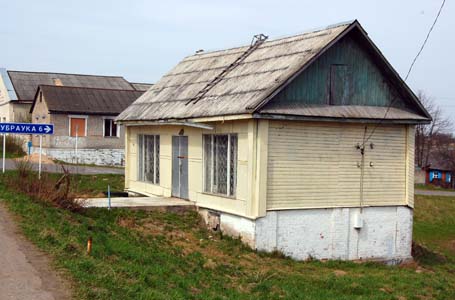 Shop, built on the foundation of the former synagogue.
Shop, built on the foundation of the former synagogue.
At the beginning of the 20th century Vetrino was a small cozy settlement. It was located along the road from Polotsk to Glubokoye. The whole settlement consisted of one street. In the center of Vetrino there was a bazaar with a synagogue not far away from it. Only a foundation is now left from that synagogue. Later a shop was built on that foundation. - What was the name of this street before the war? – I inquired. - It had the same name as now – Lenin Street. - So, this means the synagogue was in Lenin Street – such a paradox of life. - The local Orthodox church was also located in Lenin Street. There is now a Catholic church not far away. Vetrino also has a protestant church and not a single synagogue because there are no Jews left in Vetrino. The Jewish page in the history of Vetrino has been turned over. In 1838 the Jewish population of Vetrino constituted 127 people. By 1847 it had grown to 228 people. All the residents of the settlement could speak Yiddish. In 1876 the Jewish population decreased to 74 people because many of them had moved to bigger towns. - I was born in Vetrino in 1937 and still remember the prewar times a little. Before the war the Jewish population of Vetrino was 61 people. Many men were mobilized. There was no mass evacuation from Vetrino. The Nazis murdered 59 Jews, mostly women, children and old people. We approached the local memorial complex, built in memory of the Jewish residents of Vetrino. 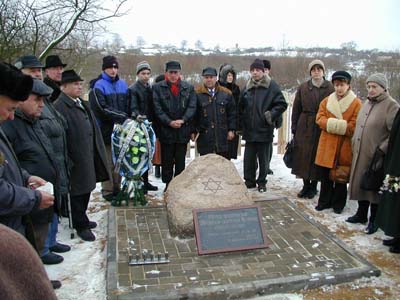 Opening of the memorial.
Opening of the memorial.
- Why did you decide to set up this memorial? - At the beginning of the 90s I was working at a school. Every day on my way to work I passed the place of the mass grave. Every time I felt agitation. There are no relatives of mine in this grave and I have no Jewish roots. I did not know the people that are buried here. But every time I was passing this place I felt empathy and agitation. I understood that something had to be done in memory of those people. 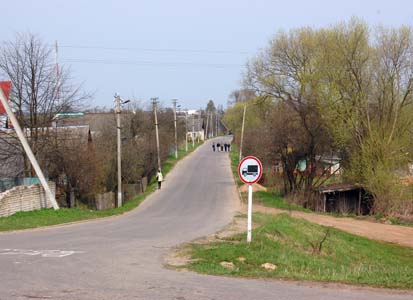 Chkalov Street – location of the ghetto.
Chkalov Street – location of the ghetto.
- How did you know that the Jews had been buried exactly in this place? - All the old residents knew about that. - Why exactly this place? - When the Germans were first bombing Vetrino, enormous shell holes were left here. The Nazis invaded Vetrino without much fighting. Soon a ghetto was formed. The following families were known to be in the ghetto: the Zaretskys (4 people), the Gindins (4 people), Samuil Gofman’s family (5 people, including 5-year-old Sonia), the Miltmans (6 people, including children aged 1, 4 and 7) and others. Among the 59 victims there were 14 children aged 1 – 14. There were two executions in Vetrino. First the ghetto prisoners were killed. One of the witnesses of the execution related that he saw two cars with Nazis arrive from Polotsk. The Jews were forced out of their houses. Two Germans were accompanying them at the front and two at the back. They were taken to a swamp near the village of Kosary (now Oktiabrskaya Street) and shot in groups of 2 – 3 people. The execution took place on a winter afternoon. On that day more than 40 Jews were killed. Local men were forced to fill up the graves with soil. Nadezhda Rybkina, whose father was forced to fill the grave, recalled that her father came home and could not talk or eat anything. 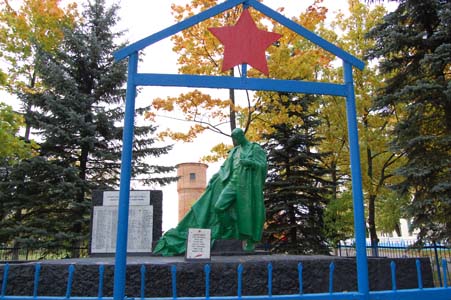 Memorial to soldiers.
Memorial to soldiers.
A week later the second execution took place. The second group of Jews, about 13 people, was shot in Labkovsky forest. No one can find that grave. - When the memorial was set up on the site of the execution the authorities and a number of organizations participated in its erection. In 2008 Victor Karasev opened a memorial stele in the village of Bykovshina next to Vetrino. The stele is in memory of the local partisans, soldiers, children and counselors of the local orphanage. 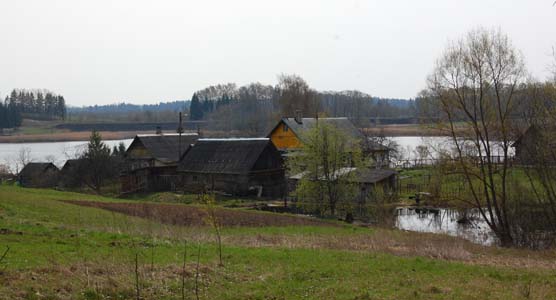 Vetrino.
Vetrino.
|
|||
|
|
Jewish settlements in Vitebsk regionVitebsk • Albrehtovo • Babinovichi • Baran • Bayevo • Begoml • Beshenkovichi • Bocheikovo • Bogushevsk • Borkovichi • Braslav • Bychiha • Chashniki • Disna • Dobromysli • Dokshitsy • Druya • Dubrovno • Glubokoye • Gorodok • Kamen • Kohanovo • Kolyshki • Kopys • Krasnopolie • Kublichi • Lepel • Liady • Liozno • Lukoml • Luzhki • Lyntupy • Miory • Obol • Oboltsy • Orsha • Osintorf • Ostrovno • Parafianovo • Plissa • Polotsk • Prozorki • Senno • Sharkovshina • Shumilino • Sirotino • Slaveni• Smolyany • Surazh • Tolochin • Ulla • Verhnedvinsk • Vidzy • Volyntsy • Yanovichi • Yezerishe • Zhary • Ziabki • |
Main |
New publications |
Contacts |
Site map |
Vitebsk region |
Mogilev region |
Minsk region |